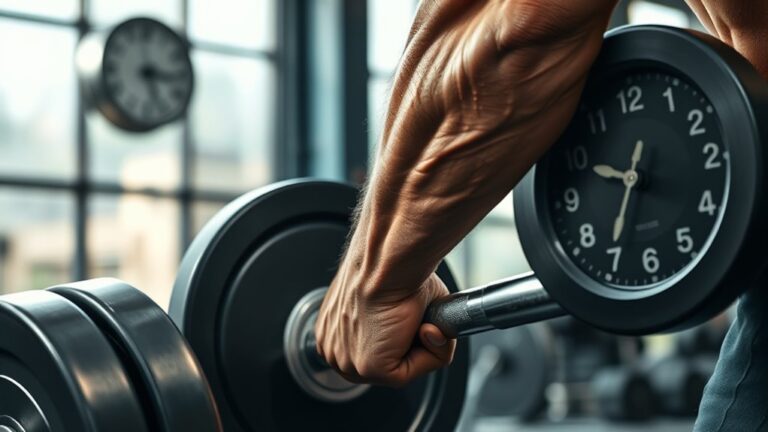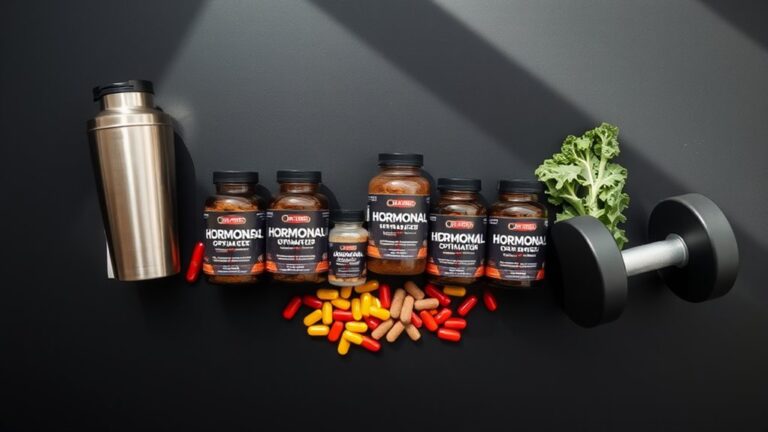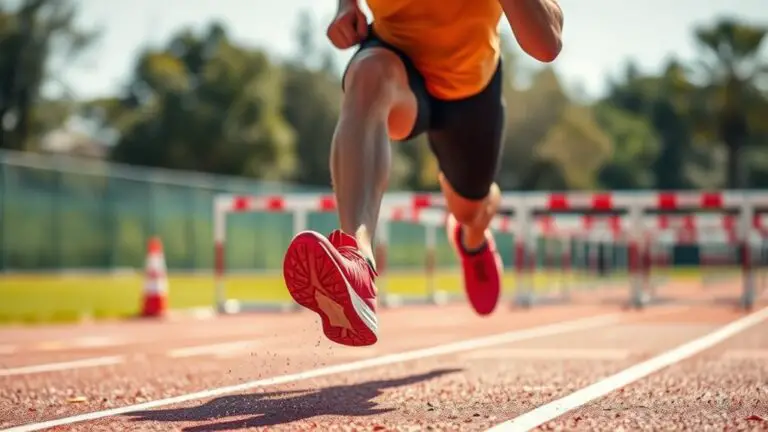The Best Gym Workouts for Karate and Taekwondo Practitioners

To boost your karate and taekwondo performance, focus on strength training that enhances power, endurance, and agility. Incorporate core exercises like planks and medicine ball slams, along with plyometric workouts such as box jumps for explosive power. Don’t forget flexibility training for improved kicks and agility drills for quicker reactions. Functional movements will further enhance your real-world application skills. Explore how to structure your workout plan for ideal results and take your training to the next level.
Importance of Strength Training for Martial Artists
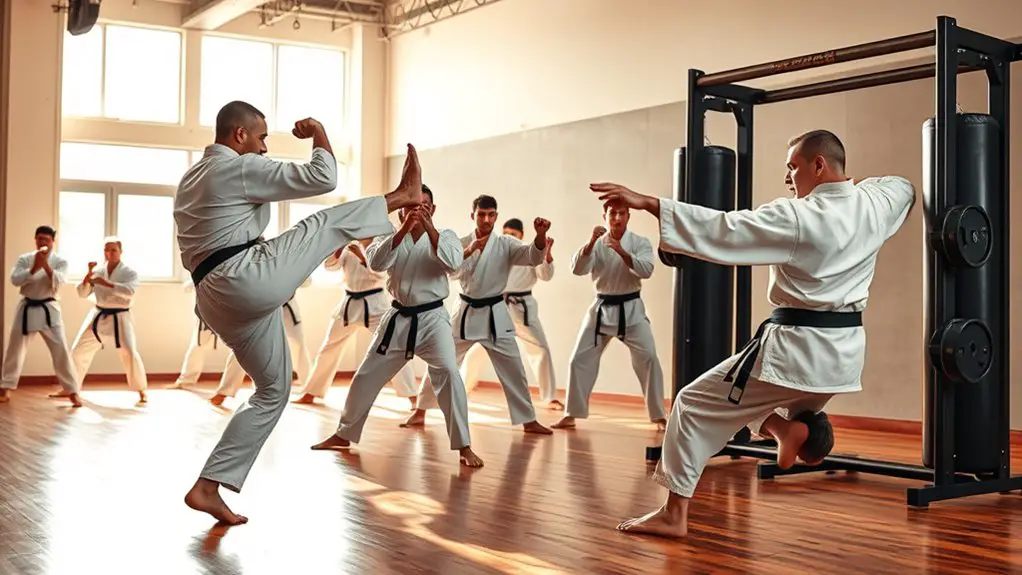
Strength training is an essential component of any martial artist’s training regimen, especially for those practicing disciplines like karate and taekwondo. By focusing on strength, you’ll not only enhance your power during strikes but also improve your overall performance. Stronger muscles contribute to better muscle endurance, allowing you to maintain technique and speed throughout your training and competitions.
Additionally, incorporating strength training into your workouts can provide significant cardio benefits. As you lift weights or perform resistance exercises, your heart rate increases, improving cardiovascular fitness. This dual benefit means you’re building muscle while simultaneously boosting endurance, essential for those high-energy bouts in martial arts.
Ultimately, a well-rounded strength training program will enhance your agility, balance, and coordination, making you a more formidable opponent on the mat. Prioritizing strength will help you advance in your martial arts journey and achieve your goals more effectively.
Essential Exercises for Building Core Strength
Core strength is crucial for martial artists, as it plays an important role in stability, balance, and power generation during techniques. To enhance your core stability, incorporate these exercises into your routine:
- Plank Variations: Hold a standard plank or try side planks to engage your obliques. Aim for 30 seconds to a minute.
- Russian Twists: Sit on the floor with your knees bent, lean back slightly, and twist your torso side to side. This strengthens rotational strength, essential for striking.
- Medicine Ball Slams: Raise a medicine ball overhead and slam it down with force. This explosive movement builds core power and stability.
Plyometric Workouts to Enhance Power and Speed
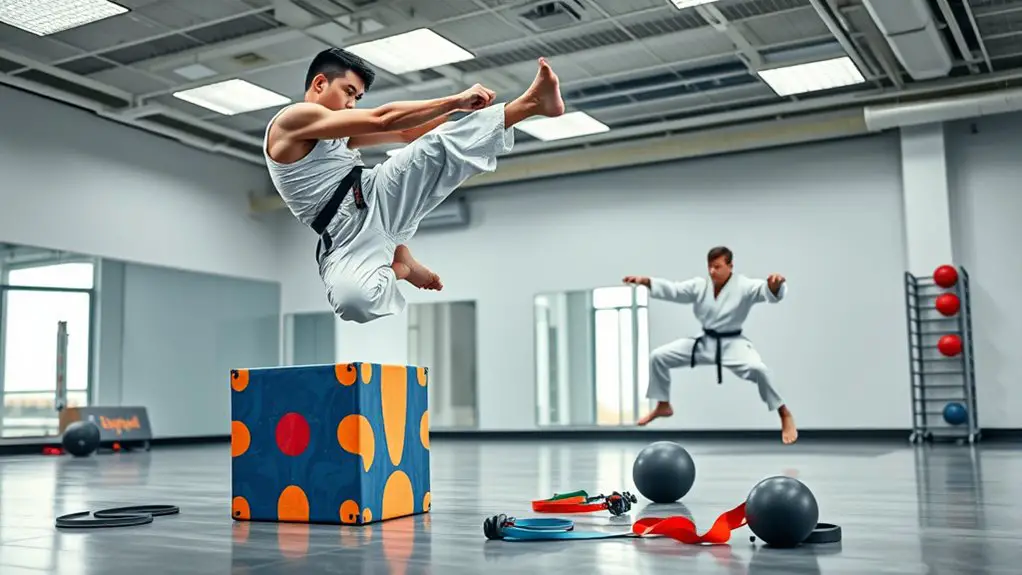
To boost your power and speed in martial arts, incorporating plyometric workouts is essential. Explosive jump exercises, agility drills, and resistance training techniques can greatly enhance your performance. By integrating these elements into your routine, you’ll develop the explosive strength needed for powerful kicks and swift movements.
Explosive Jump Exercises
While mastering martial arts like karate and taekwondo, incorporating explosive jump exercises into your training regimen can greatly enhance your power and speed. These plyometric workouts focus on developing your fast-twitch muscle fibers, vital for those high kicks and quick movements. Here are three effective exercises to take into account:
- Box Jumps: Use box jump techniques to increase your vertical leap. Start from a squat, jump onto the box, and land softly to minimize injury risk.
- Depth Jumps: Step off a box and explode upwards upon landing, training your muscles to react quickly.
- Broad Jumps: Focus on horizontal distance to improve your overall explosiveness, critical for dynamic martial arts movements.
Incorporate these into your routine, and you’ll notice significant improvements in your performance.
Agility and Coordination Drills
Building on the explosive power gained from jump exercises, agility and coordination drills are essential in refining your overall performance in karate and taekwondo. These drills enhance your reaction time, allowing you to respond swiftly to opponents’ movements. Incorporating ladder drills, cone sprints, and lateral hops not only boosts your speed but also sharpens your footwork.
Balance training is vital here; it improves your stability during dynamic movements, ensuring you maintain control while executing techniques. Try single-leg balance exercises or stability ball workouts to complement your agility drills. By integrating these workouts into your routine, you’ll develop the quickness and coordination necessary for effective striking and evasion, ultimately elevating your martial arts skills to new heights.
Resistance Training Techniques
Incorporating resistance training techniques, particularly plyometric workouts, can considerably enhance your power and speed in karate and taekwondo. Utilizing resistance training principles, these exercises focus on explosive movements that build strength and agility. Here are three effective plyometric workouts you can try:
- Box Jumps: Jump onto a sturdy platform to develop leg power.
- Resistance Band Variations: Use bands for explosive punches and kicks, improving your striking speed.
- Depth Jumps: Step off a box and jump immediately upon landing to enhance reactive strength.
Flexibility Training Techniques for Improved Kicks
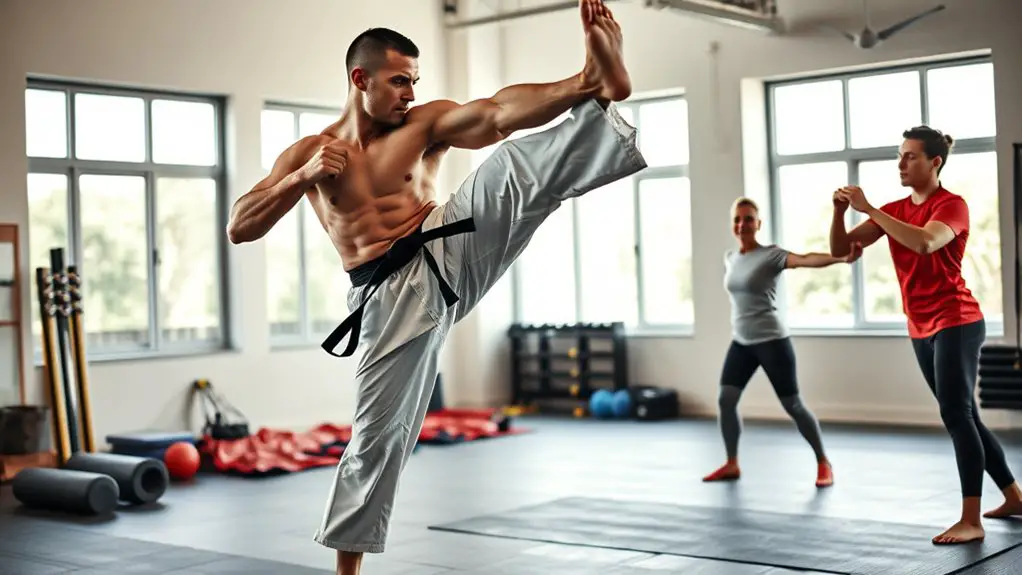
To enhance your kicking ability in karate and taekwondo, incorporating effective flexibility training is essential. Dynamic stretching exercises can prepare your muscles for action, while static stretching routines help maintain and improve your overall flexibility. By mastering these techniques, you’ll notice a significant boost in your kicking range and precision.
Dynamic Stretching Exercises
Dynamic stretching exercises are essential for improving flexibility and enhancing your kicking techniques in both Karate and Taekwondo. Incorporating these dynamic warm-ups into your training routine not only prepares your muscles but also aids in active recovery after intense workouts. Here are three effective dynamic stretching exercises you should include:
- Leg Swings: Stand on one leg and swing the opposite leg forward and backward, keeping your movements controlled.
- Walking Lunges: Step forward into a lunge position, alternating legs to stretch hip flexors and hamstrings dynamically.
- High Knees: Jog in place while lifting your knees to hip height, engaging your core and warming up your lower body.
These exercises will help you achieve greater range of motion and more powerful kicks.
Static Stretching Routines
Static stretching routines play an essential role in enhancing flexibility, which is important for executing high and powerful kicks in Karate and Taekwondo. By incorporating static stretch techniques into your training regimen, you can target specific muscle groups, such as your hamstrings, quadriceps, and hip flexors. Holding stretches for 20-30 seconds allows your muscles to elongate, improving your range of motion. The benefits of flexibility extend beyond just kick height; they also reduce the risk of injury and improve overall performance. To maximize your flexibility, consider adding post-workout static stretches to your routine. This will not only aid recovery but also help you achieve those impressive kicks that can set you apart in the dojo or on the mat.
Agility Drills to Increase Quickness and Reaction Time
While mastering martial arts techniques like karate and taekwondo is essential, enhancing your agility can markedly improve your performance in the dojo. Agility drills focus on quickness and reaction time, allowing you to respond faster in critical moments. Here are three effective drills you can incorporate into your routine:
Improving your agility with targeted drills can significantly boost your martial arts performance and responsiveness in the dojo.
- Cone Drills: Set up cones in various patterns. Dash between them, practicing quick changes of direction to improve footwork and speed.
- Lateral Bounds: Jump side-to-side over a line or small obstacle. This quickness exercise develops explosive lateral movement, vital for dodging attacks.
- Reaction Ball Training: Use a reaction ball that bounces unpredictably. Catch it as it bounces to enhance your reflexes and improve hand-eye coordination.
Incorporating these drills into your training will elevate your performance and give you an edge in sparring sessions.
Endurance Workouts to Boost Stamina
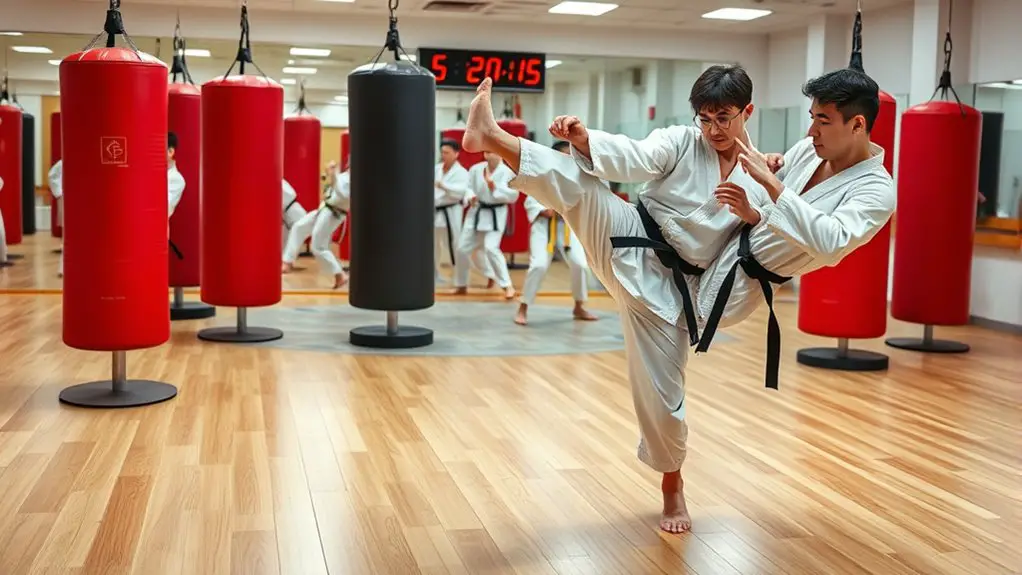
To excel in karate and taekwondo, enhancing your stamina through targeted endurance workouts is essential. Incorporating high-intensity interval training, circuit training, and steady-state cardio can greatly improve your performance in the dojo. Each method offers unique benefits that can help you maintain energy levels during intense sparring or competition.
High-Intensity Interval Training
High-Intensity Interval Training (HIIT) can greatly enhance your stamina, making it an essential component of your martial arts training regimen. By incorporating HIIT techniques into your workouts, you’ll improve your endurance for those intense sparring sessions. Here are three effective strategies to implement:
- Tabata Intervals: Perform 20 seconds of maximum effort, followed by 10 seconds of rest, for eight rounds. This quick burst enhances both aerobic and anaerobic capacity.
- Fartlek Training: Mix fast-paced sprints with slower recovery periods, mimicking the unpredictable nature of sparring.
- Circuit HIIT: Combine strength exercises with cardio for short, intense intervals, maximizing your workout efficiency and boosting stamina.
These workout intervals will keep your body challenged and ready for any martial arts competition!
Circuit Training Benefits
Circuit training offers a dynamic way to enhance endurance, making it an ideal choice for martial artists looking to boost their stamina. This method involves a series of exercises performed in succession, allowing you to vary your circuit variations while maintaining high workout intensity. By incorporating different movements, you can target multiple muscle groups and keep your body engaged.
| Circuit Variation | Benefits |
|---|---|
| Bodyweight Exercises | Improves strength and endurance |
| Plyometric Drills | Enhances explosiveness |
| Resistance Training | Builds muscle and power |
Incorporating circuit training into your routine not only increases your stamina but also keeps workouts engaging, pushing you further in your martial arts journey.
Steady-State Cardio Techniques
While circuit training effectively boosts endurance, steady-state cardio techniques play an essential role in developing stamina for martial artists like you. These workouts maintain a consistent cardio intensity, allowing your body to adapt and improve over time. Here are three effective steady-state cardio techniques to incorporate into your routine:
- Running or Jogging: Aim for a steady pace, focusing on breathing and form.
- Cycling: Use a stationary bike or hit the road, maintaining a moderate speed to build endurance.
- Rowing: Engage multiple muscle groups while keeping a steady rhythm, enhancing both stamina and strength.
These steady state benefits help improve your cardiovascular health, enabling longer training sessions and better performance in karate and taekwondo.
Functional Movements for Real-World Application
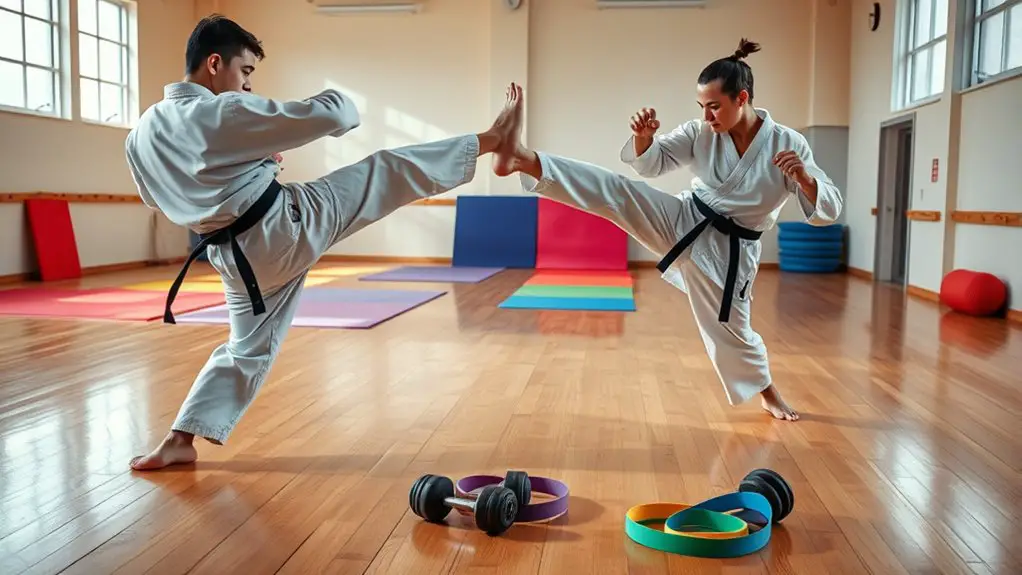
When you incorporate functional movements into your gym workouts, you’re not just building strength; you’re enhancing your ability to perform in real-world scenarios. Functional fitness focuses on exercises that mimic everyday activities, improving your agility, balance, and coordination. For karate and taekwondo practitioners, this means developing movements that translate directly to your martial arts skills.
Think about exercises like squats, lunges, and kettlebell swings. These movements engage multiple muscle groups, boosting your stamina and power during kicks and strikes. They also prepare you for unexpected challenges outside the dojo, like lifting or dodging. Goblet squat is an excellent alternative that reduces strain while still building lower body strength.
Incorporating functional movements into your routine helps you become more adaptable. You’ll find yourself responding better to opponents and maneuvering through various situations in daily life. By emphasizing real-world applications, you’re not only training for competition but also enhancing your overall physical literacy.
Incorporating Resistance Bands Into Your Routine
Incorporating resistance bands into your routine can greatly enhance your strength training, especially for martial arts like karate and taekwondo. These bands offer unique band resistance benefits, allowing you to engage muscles in a way that complements your martial arts practice. Plus, they add workout variety, preventing boredom and promoting consistent training.
Here are three effective ways to use resistance bands:
- Leg Extensions: Secure the band around your ankles and perform leg extensions to strengthen your quads, which aids in powerful kicks.
- Chest Presses: Anchor the band behind you and push forward, mimicking the motion of a punch. This targets your chest and shoulders for stronger strikes.
- Rotational Twists: Attach the band to a stable point and twist your torso against the resistance, enhancing your core strength for improved balance and power.
Incorporating these exercises can elevate your martial arts performance!
Recovery and Mobility Exercises for Injury Prevention
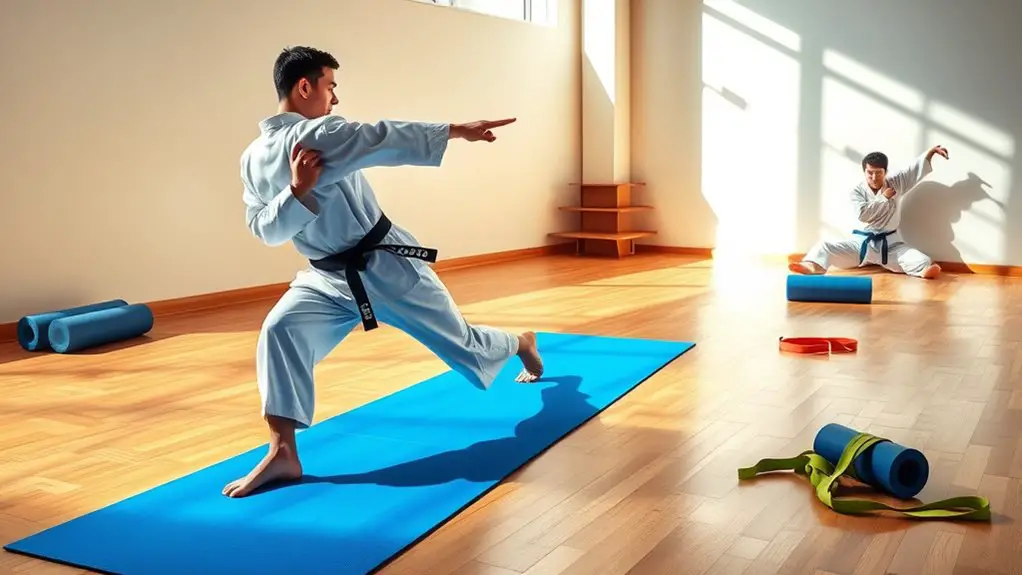
After focusing on strength training with resistance bands, it’s important to shift your attention to recovery and mobility exercises that play an essential role in injury prevention. Incorporating foam rolling into your routine can greatly enhance your recovery process. By targeting tight muscles and fascia, foam rolling helps release tension, improve blood flow, and promote muscle elasticity.
Additionally, practice active recovery techniques, such as light jogging, dynamic stretching, or yoga. These activities keep your body engaged while allowing your muscles to recover. They also enhance flexibility, which is critical for executing high kicks and evasive maneuvers in karate and taekwondo. Proper warm-up techniques before engaging in high-impact activities can further safeguard your knees and joints against injury.
Don’t overlook the importance of cooldown sessions post-training. Spend a few minutes on mobility drills, focusing on areas like your hips, shoulders, and ankles. This thorough approach to recovery will not only keep you injury-free but also improve your overall performance in martial arts.
Structuring Your Workout Plan for Optimal Results
To achieve ideal results in your martial arts training, it is crucial to structure your workout plan effectively. This involves understanding your goals, establishing workout frequency, and ensuring balanced training. Here’s how you can optimize your plan:
- Define Your Goals: Whether you’re aiming for improved flexibility, strength, or sparring techniques, having clear goals will guide your training focus.
- Establish Workout Frequency: Aim for 3-5 sessions per week, allowing for sufficient recovery. Consistency is key to making progress.
- Incorporate Variety: Mix in strength training, cardio, and skill work. This not only keeps your routine engaging but also addresses different aspects of martial arts performance. Additionally, incorporating activities like skipping rope can enhance cardiovascular fitness and overall strength.
Frequently Asked Questions
How Often Should I Change My Workout Routine?
You should consider changing your workout routine every 4 to 6 weeks to maintain workout variety and enhance routine effectiveness. Sticking to the same exercises can lead to plateaus, making it harder to achieve your fitness goals. By mixing things up, you keep your body challenged and engaged, which can prevent boredom and promote better results. Whether it’s altering your exercises, intensity, or duration, regular adjustments can keep your workouts fresh and effective.
What Should I Eat Before Training Sessions?
You’ll feel like a superhero when you fuel up right before training! For peak performance, consider pre-training snacks like bananas, Greek yogurt, or energy bars. These provide quick energy without weighing you down. Don’t forget hydration, either—drink water well before your session to stay sharp. Aim for at least 16 ounces an hour prior. With the right nutrition and hydration tips, you’ll be ready to conquer any challenge that comes your way!
Can I Train at Home Instead of the Gym?
Absolutely, you can train at home instead of the gym! Home workouts can be just as effective if you’re creative with your routine. You don’t necessarily need fancy equipment; alternatives like resistance bands, bodyweight exercises, or even household items can offer great resistance. Just guarantee your space is safe, and you’re consistent. With dedication, you can build strength and improve your skills right from your living room!
What Supplements Are Beneficial for Martial Artists?
Think of supplements as the fuel that powers your martial arts engine. For ideal performance, consider protein powders; they’re like the building blocks your muscles crave after intense training. Recovery drinks are equally important, acting as your body’s soothing balm post-workout, replenishing lost nutrients and speeding up recovery. Together, they create a winning combination, ensuring you’re not just training hard but recovering smart, ready to face your next challenge with renewed vigor.
How Do I Track My Progress Effectively?
To track your progress effectively, consider using progress journals and fitness apps. Journals allow you to document your workouts, techniques, and personal reflections, providing a detailed view of your growth. Fitness apps can help you log your training sessions, monitor metrics like strength and endurance, and even set goals. By combining both methods, you’ll gain valuable insights into your performance, helping you stay motivated and make informed adjustments to your training regimen.


